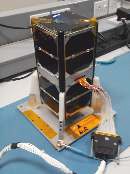SathyabamaSat (SB Sat)

SathyabamaSat (SB Sat) is a 2-Unit CubeSat developed and built by Sathyabama University, India. The spacecraft measures 10 by 10 by 20 centimeters in size and weighs 1.5 Kilograms.
It has the usual characteristics of a CubeSat with body-mounted solar arrays for power generation and communications in the UHF band, however, unlike many CubeSats of comparable size, the spacecraft makes use of an active attitude control system with magnetometers used for attitude determination and magnetic torque rods for three-axis control.
The main payload of SB Sat is an Argus 1000 Infrared Spectrometer, a commercial device marketed for application in CubeSat missions studying atmospheric species. The grating spectrometer unit is only 4.5 x 5 x 8 centimeters in size, making it ideally suited for a CubeSat mission. Light entering the instrument is dispersed by a 300 groove/mm grating and directed onto a 256-element Indium-Gallium-Arsenide detector array cooled by a Peltier cooler to reduce dark currents.
The spectrometer covers a spectral range of 1.0 to 1.7 micrometers with a 6-nanometer spectral resolution across 100 spectral channels. Atmospheric species absorbing within the instrument’s spectral range are oxygen, carbon dioxide, water, carbon monoxide, methane and hydrogen fluoride. Argus supports integration times between 0.5 and 4 seconds.
The instrument on SB Sat will only be operated over regions the mission’s operators are interested in, collecting data on green house gas emissions.
